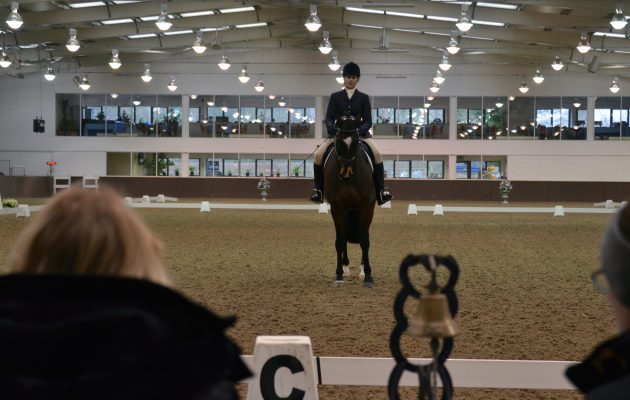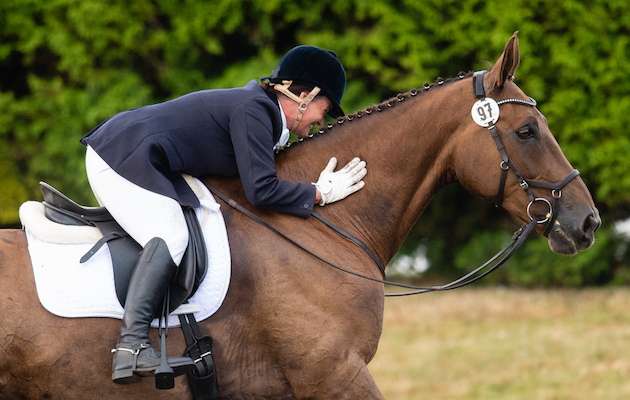At the recent United States Eventing Association Annual Meeting and Convention, judge Marilyn Payne gave a talk providing advice on riding the new 2020 FEI eventing dressage tests — which she worked with a team of judges to write. Marilyn was president of the ground jury at the Rio Olympics, so she definitely knows her stuff!
Whether you are riding at grassroots level or five-star, Marilyn had some useful tips to pass on to help you squeeze every possible mark out of your test. Here are some of our favourites:
1. In a good free walk on a long rein, the horse stretches down as far as he likes — his nose can be as low as his knees. It’s best for the rider to keep a contact as this will improve the quality of the walk and make it easier to pick the horse back up without him resisting. But the vital factors are the quality of the walk, the length of the horse’s stride and the swing over the back.
2. In extended walk, the horse lengthens his frame and the stride will lengthen, but there should not be a loop in the reins — the rider should maintain contact. The horse’s neck should be longer and his nose lower than in medium walk, but the nose should not be beyond the point of the shoulder.
3. In medium walk, the horse must still be marching and have overtrack. When riders come out of extended walk, the medium walk is often too short and the horse is not tracking up — make sure it’s a medium walk, not collected.
4. If there are separate scores for halt and rein-back, make sure you stand for at least three seconds. If the halt is not held, you will lose marks for the halt but also for the rein-back as it looks like the horse is anticipating.
5. When performing a stretch in trot or canter, keep the contact; don’t throw the reins away. The balance, rhythm, tempo and quality of the gait should not change and the judge should see a stretch over the back. The horse’s nose should be beyond the point of the shoulder, but not come behind the vertical. If a full circle is given for the movement, it’s impressive to get to the stretch quickly, but perfectly acceptable to use the first quarter to develop the stretch, the middle half to maintain it and the last quarter to pick up so the horse is back in a normal frame by the last marker. If the horse resists in the pick-up, it was a “cheater stretch” and the horse wasn’t really seeking the contact.
6. A give and re-take of the reins requires a clear release of the reins for three or four strides. The rider should hold the hands high and push them forward to make it really clear, but nothing should change in the horse’s frame — he should maintain self-carriage, rhythm, tempo, straightness and the quality of the gait. The rider should hold him with the seat and back, saying “stay up here”.
7. A turn on the haunches can be around a circle 1m wide and the horse can take quite a few steps. The difference with a half-pirouette is that the hindlegs should stay nearly in place and the horse should take only three or four steps for a really high score. But it’s better to to a slightly large half-pirouette than get stuck by trying to do one smaller than the horse is ready for, as getting stuck will be heavily penalised.
8. If you are asked for a change of canter lead through trot over X, you should trot before X and canter again after X so the transition is placed centrally over the letter. Don’t make the transition to trot at X.
Article continues below…
You might also be interested in:

Enter at A and make a winning impression: 6 tips to help you ride a perfect centre line
Riding a centre line might sound simple, but a particularly good one can be tricky to achieve, especially if there

Start winning the 2020 eventing season, now: how to hit the ground running
Here’s some helpful pointers on how you can best prepare over the off-season months for the eventing season ahead

Subscribe to Horse & Hound magazine today – and enjoy unlimited website access all year round
9. If the horse breaks in counter canter, you should try to regroup and get the counter canter back so you get some marks for the counter canter and get the mark for the transition out of it. Similarly, if a horse makes a flying change really early, you should try to change back and perform the flying change again at the right place.
10. Most people ride 10m circles too big. Get someone to watch you when you practise and tell you if you are doing them the right size.
11. Don’t forget to ride the end of movements and the bits in between. If you are asked to make a straight line after a half-pass, for example, you could lose the marks gained in a good half-pass if you don’t go straight. Conversely, if the judge is wavering between two marks and you do an impressive straight line, you could nudge them to the higher score.
Would you like to read Horse & Hound’s independent journalism without any adverts? Join Horse & Hound Plus today and you can read all articles on HorseandHound.co.uk completely ad-free.




